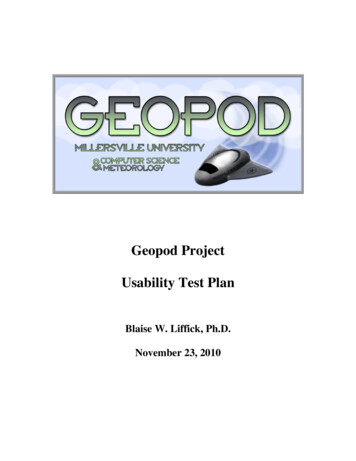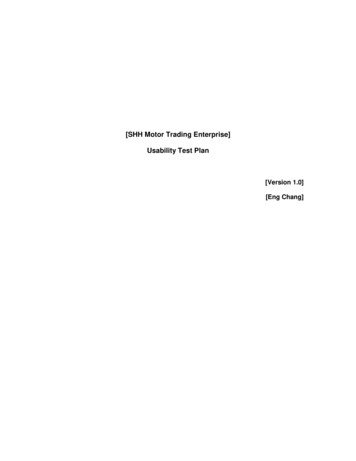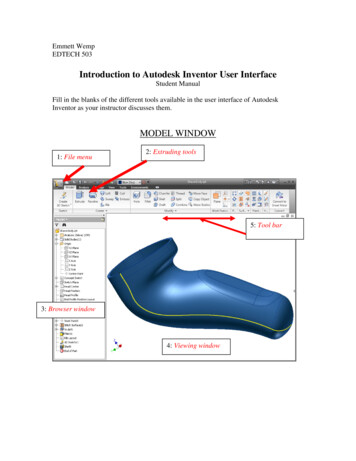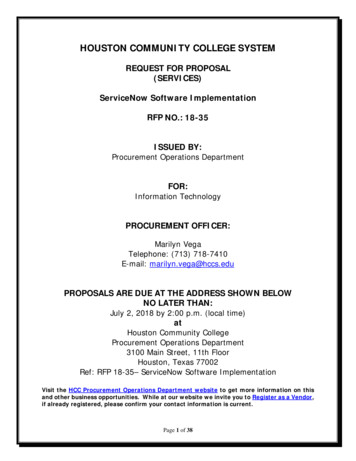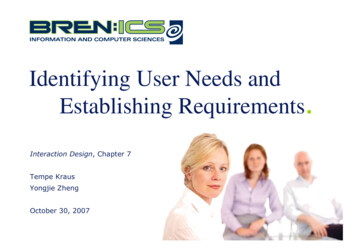
Transcription
Identifying User Needs andEstablishing Requirements.Interaction Design, Chapter 7Tempe KrausYongjie ZhengOctober 30, 2007
Outline What are we trying to achieve?– Identifying needs and establishing requirements– Categories of requirements Data gathering techniques– Choosing between data gathering techniques– Data gathering guidelines Data interpretation and analysis Task description and analysis– Scenarios, use cases, essential use cases and task analysis Summary Additional References2
In the beginning. What are we trying to achieve? Identifying needs:– Understand as much as possible about the users, as well as their work and the context of theirwork.– System under development should support users in achieving their goals. Identifying needs is crucial to our next step. Establishing requirements:– Building upon the needs identified, produce a set of requirements. A user-centered approached to development:– Study that investigated the causes of IT project failure found that “requirements definition” wasthe most frequently cited project stage that caused failure.– Understanding what the product should do and making sure it meets the stakeholders’ needs areabsolutely critical to the success of the product.3
What are requirements? A requirement is a statement that specifies what an intended product should do, orhow it should perform. Traditionally, two types of requirements:– Functional requirements specify what the system should do.– Non-Functional requirements specify what constraints there are on the system or itsdevelopment. Interaction design requires us to understand both the functionality required and theconstraints for development or operation of the product. Let’s refine these two broad types into further categories.4
Categories of requirementsCategory Functional requirements What the product should do. Data requirements The type, volatility, size/amount, persistence,accuracy and value of the amounts of therequired data. Environmental requirements Or “context of use” – circumstances in which theinteractive product must operate. User requirements Characteristics of the intended user group. Usability requirements The usability goals and associated measures.Source: Interaction Design, ch. 75Description
Data gatheringOverview of data gathering techniques used in the requirements ve andqualitative dataCan reach many peoplewith low resourceDesign is crucial andresponse rate may below. Responses maynot be useful.Exploring issuesSome quantitativebut mostly qualitativedataInterviewer can guideinterviewee if necessary.Encourages contactbetween developers andusers.Time consuming.Artificial environmentmay intimidateinterviewee.Focus groupsand workshopsCollecting multipleviewpointsSome quantitativebut mostly qualitativedataHighlights areas ofconsensus and conflict.Encourages contactbetween developers andusers.Possibility of dingcontext of useractivityQualitativeObserving actual workgives insights that othertechniques can’t giveVery time consuming.Huge amounts ofdata.StudyingdocumentationLearning aboutprocedures,regulations andstandardsNo time commitmentfrom users requiredDay-to-day workingwill differ od forAnswering specificquestionsSource: Interaction Design, ch. 76Kind of dataQuantitative
Choosing between data gathering techniques Your choice is influenced by a number of factors. The kind of information you want.– May also change depending on the stage of the project. The resources available to you.– E.g., your project may not have the time, money or personnel to send out a nationwide survey. The location and accessibility of stakeholders.– You may want to run a workshop for a large group of stakeholders, but could be prohibited bygeography.7
Choosing between data gathering techniques, continued Two main issues to consider when making your choice:– The nature of the data gathering technique itself.– The task which is to be studied. Data gathering techniques differ in the following:– The amount of time they take, level of detail and risk associated with the findings.– The knowledge the analyst must have about basic cognitive processes. Tasks can be classified along three scales:– Is the task a set of sequential steps or is it a rapidly overlapping series of subtasks?– Does the task involve high information content with complex visual displays, or low informationcontent, where simple signals are enough to alert the user?– Is the task intended to be performed by a laymen with minimal training, or a practitioner highlyskilled in the task domain? Example: the design of an ATM vs. the design of a system to support back-roomworkers at a bank who are reconciling the machine register with the customers’deposit slip.8
Basic data gathering guidelines Focus on identifying the stakeholders’ needs. Involve all the stakeholder groups. Involve more than one representative from each stakeholder group. Use a combination of data gathering techniques. Support the data-gathering sessions with suitable props. Run a pilot session if possible, to work out any kinks. Understand what you are really looking for (though compromise may be needed). Carefully consider the means used to record the data during a face-to-face datagathering session.9
Data interpretation and analysis Once you have gathered your data, you will need to interpret and analyze it.– Start interpretation and analysis as soon after the gathering session as possible. Interpreting data:– Begin structuring and recording descriptions of requirements.– Capture information in documents and diagrams.– This helps to keep track of context and usage information during the rest of the process. Analyzing data:– Data-flow diagrams, state charts, work-flow charts, etc.– For object-oriented approaches, can use class diagrams, sequence diagrams, etc. Requirements activity iterates numerous times before stable requirements evolve.– Continued interpretation and analysis throughout the process will result in a deeperunderstanding as well as clarification of the requirements. We will focus on four techniques that have a user-centered focus and are intended tounderstand the users’ goals and tasks.10
Task description and analysis User-centered task descriptions are created to understand users’ goals and tasks.– Scenarios– Use cases– Essential use cases– Task analysis Methodology for each:– Description– Advantages– Limitations– How to develop Example:– The shared calendar application System-centered descriptions are used to communicate precise information withdevelopers.11
Task description and analysis, continuedScenarios12DescriptionDescribes human activities or tasks in a story that allowsexploration and discussion of contexts, needs, andrequirements.AdvantagesTelling a story is a natural way for people to explain whatthey are doing or how to achieve something. It also allowsus to identify the stakeholders and the products involved inthe activity.LimitationsMore focused on task characteristics than the detail ofinterface design and layout. [2]To DevelopFocus on what users are trying to achieve.
Task description and analysis, continued Scenarios: the shared calendar exampleSource: Interaction Design, ch. 713
Task description and analysis, continuedUse Cases14DescriptionThe main emphasis is on user-system interaction, but alsouser goals.AdvantagesIt is easy to grasp key features in the user-systeminteraction activities.LimitationsTraditional use cases contain certain assumptions, includingthat there is a piece of technology to interact with, and thekind of interaction to be designed.To DevelopIdentify the actors, then examine these actors and identifytheir goal or goals in using the system.
Task description and analysis, continued Use cases: the shared calendar example1. The user chooses the option to arrange a meeting2. The system prompts user for the names of attendees3. The user types in a list of names4. The system checks that the list is valid5. The system prompts the user for meeting constraints6. The user types in meeting constraints7. The system searches the calendars for a date that satisfies the constraints8. The system displays a list of potential dates9. The user chooses one of the dates10. The system writes the meeting into the calendar11. The system emails all the meeting participants informing them for the appointmentAlternative courses:5. If the list of people is invalid5.1 The system displays an error message5.2 The system returns to step 28. If no potential dates are found8.1 The system displays a suitable message8.2 The system returns to step 5Source: Interaction Design, ch. 715
Task description and analysis, continuedEssential Use Cases16DescriptionA structured narrative consisting of three parts: a namethat expresses the overall user intention, a steppeddescription of user actions, and a stepped description ofsystem responsibilities.AdvantagesRepresents a more general case than a scenario embodies,and tries to avoid the assumptions of a traditional use case.LimitationsDifficult to capture concrete and specific activities whilemaintaining the generality required.To DevelopIdentify user roles, then examine these roles and identifythe users’ goal or goals in using the system.
Task description and analysis, continued Essential use cases: the shared calendar exampleSource: Interaction Design, ch. 717
Task description and analysis, continuedTask Analysis18DescriptionUsed to analyze the underlying rationale and purpose ofwhat people are doing: what are they trying to achieve,why are they trying to achieve it, and how are they goingabout it, e.g. Hierarchical Task Analysis (HTA) & GOMS.AdvantagesTask analysis establishes a foundation of existing practiceson which to build new requirements or to design new tasks.LimitationsIn the hands of inexperienced practitioners, too much levelof detail may be entered into; for systems with diffuseobjectives, time may be wasted by attempting to apply taskanalysis to intractable material. [2]To DevelopBreak a task down into subtasks and then into sub-subtasksand so on.
Task description and analysis, continued Task analysis: the shared calendar example (1 – text form)Source: Interaction Design, ch. 719
Task description and analysis, continued Task analysis: the shared calendar example (2 – diagram form)Source: Interaction Design, ch. 720
Task description and analysis, continued Developers-centered descriptions: more formal, more specialized [4]– Entity-Relationship diagrams– Class diagrams– Ontologies– Goals– Finite State Machines21
Summary “Getting the requirements right is crucial to the success of the interactive product.” There are different types of requirements:– Functional, data, environmental, user and usability.– Every system will have requirements under each of these headings. Most commonly used data-gathering techniques for establishing requirements include:– Questionnaires, interviews, workshops or focus groups, naturalistic observation, and studyingdocumentation. Describing user tasks such as scenarios, use cases and essential use cases can help toarticulate existing user work practices.– They also help to express envisioned use for new devices. Task analysis techniques help to investigate an existing situation, i.e. existing systemsand current practices.22
Additional References1. Sommerville, Ian; Software Engineering, Sixth Edition; Addison-Wesley, Boston, MA(2000).2. Scenario Building, scenario.htm3. Schneiderman, Ben and Plaisant, Catherine; Designing the User Interface, FourthEdition; Addison-Wesley, Boston, MA (2005).4. van Vliet, Hans; Software Engineering: Principles and Practice, First Edition; JohnWiley & Sons, Ltd (2000).23
24
A requirement is a statement that specifies what an intended product should do, or how it should perform. Traditionally, two types of requirements: –Functional requirements specify what the system should do. –Non-Functional requirements specify wha



